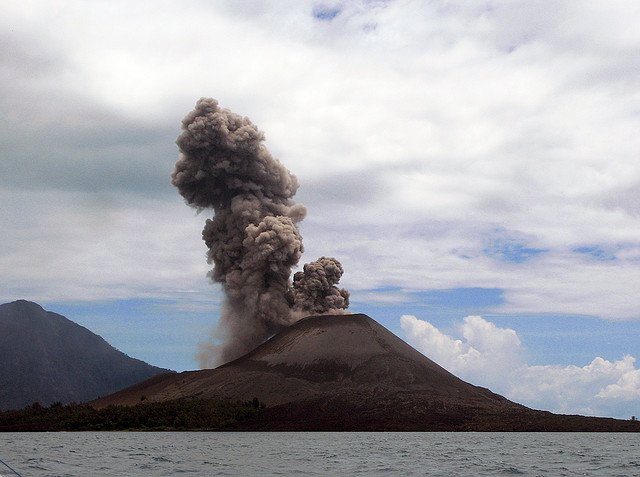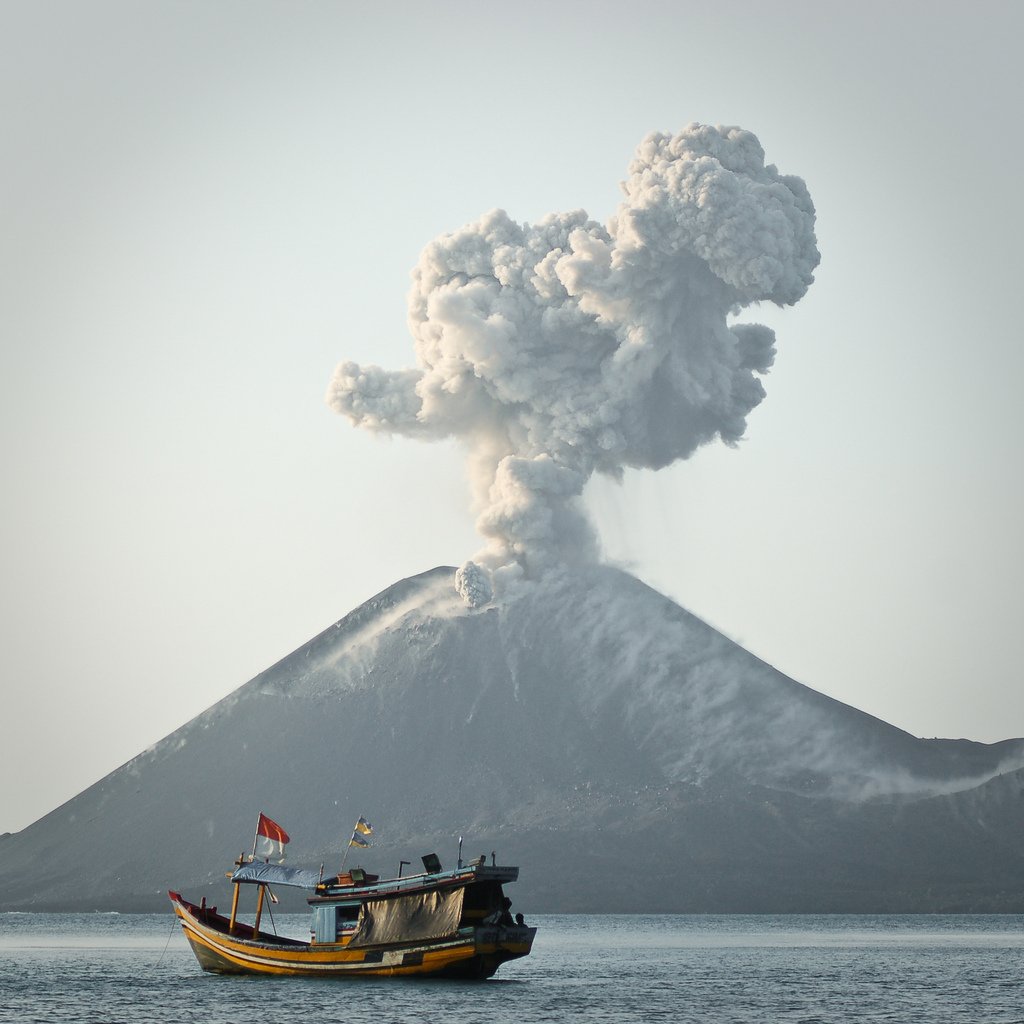Krakatau Volcano (Anuk Krakatau)
Krakatau is an island and an active volcano of the same name in Indonesia, located in the Gulf of Sound between the islands of Sumatra and Java. Krakatau volcano is famous not for its size, but for the most powerful eruption with catastrophic consequences that occurred in 1883. From the natural cataclysm shook the entire planet – the explosive wave circled the Earth several times.










Video: eruption of the Krakatoa volcano
% ContentsHistory

The Krakatau volcano has always been very restless. Extant written records show frequent violent eruptions that terrified the local population. In 416 the top of the mountain collapsed, and in its place there was a crater, parts of which became separate islands. And in 535 Krakatau caused another natural disaster, which contributed to the formation of the Strait of Zonda, which since that time separates Sumatra and Java.
.
But the worst was yet to come – the eruption triggered a huge 30-meter tsunami that washed more than 300 settlements into the ocean. The disaster killed more than 36,000 people, and some estimates put the number as high as 80,000.
>
Fifty-four minutes after the first explosion, a second, equally powerful explosion followed, but without an accompanying tsunami. A third fiery outbreak occurred a few hours later. All night the volcano was shaken by explosions, ash rain fell from the sky, the sea was puffing huge waves. Powerful currents carried numerous fishing boats into the ocean.
.
Just 10 hours after the eruption began, the air wave triggered by the volcano explosion reached Berlin at a speed of 1000 kilometers per hour. And for several more days, German weather stations recorded the passage of air currents driven by the blast wave.
In the following days, the eruption began to gradually weaken, but it took Krakatoa six months to completely subside. Until February 1884, the exhausted island shuddered with explosions. But the consequences of the elements still long made themselves known – the ash was in the Earth’s atmosphere for several years, which caused a cooling of the planet’s climate.
.
Krakatoa volcano after the cataclysm
Several decades after the eruption, the fire-breathing mountain began to revive. In the winter of 1927, an underwater eruption occurred at the site of the destroyed Krakatoa. A few days after this event, a small 9-meter volcano appeared above the water, named “Anuk Krakatau”, which means “Krakatau’s Child” by the anxiously watching people. The formidable crumb of pumice and ash collapsed several times, but three years later, intense lava flows formed a new volcano. By 1933, the baby cone had already grown to 67 meters.
.
Since 1950, Anuk Krakatau has been actively growing due to small but frequent eruptions – every week its height increases by 13 centimeters, i.e. by almost 7 meters per year. Currently, the young volcano has grown to 813 meters, its area is 10.5 square kilometers, and its diameter is 4 kilometers. The last activity was recorded on Anuk Krakatau in mid-February 2014, when more than 200 volcanic earthquakes occurred. But for now, the danger of the toddler is rated at 2 on a 4-point system.
.Indonesian authorities do not allow locals to settle in the three-kilometer zone around the island. Economic activity is prohibited within 1.5 kilometers of Anuk Krakatau, and tourists and fishermen are not allowed to approach the island at the same distance.
Some volcanologists believe that the volcano’s volcano is a “volcano”.
Some volcanologists believe that the activity of the teeming volcano will increase over time. More optimistic scientists believe that the small size of the young Krakatoa will not allow it to stage an all-planetary catastrophe once again.
.
On the example of the cataclysm that occurred on the volcano, nature has demonstrated its extraordinary ability to recover – after three years on the lifeless rocks of nearby islands began to appear ferns, then flowering plants and insects. By the end of the XIX century on the islands affected by the volcanic disaster, life returned – here revived mangrove forests and jungles, settled animals and people.
.
On the Javanese peninsula of Ujung Kulon, which is only 133 kilometers from the Krakatau volcano, a national nature park was established, which is home to wild forest bull, red wolf, gibbon, smoky leopard. The reserve is home to the last remaining Javan rhinoceros on Earth, of which there are no more than 50 individuals. In 1992, the park, which includes the volcano, was placed under UNESCO protection to preserve the largest lowland rain forest growing here.
.
On Anuk Krakatau itself, the terrain is fairly deserted, with only a small forest growing on one side of the island, where the remains of weather stations destroyed by frequent eruptions can be seen. The consequences of the explosion are visible even now – where there used to be a mountain, you can clearly see a concave inward notch. The coastline of the island is constantly changing due to eruptions. Smoke comes not only from the crater of the volcano, but oozes from all the cracks of the mountain, giving the impression that the land is constantly on fire. At the foot of Krakatoa, hills of black volcanic sand alternate with lava and ash.Krakatoa fascinates with an exciting sense of danger, and there are many brave people who want to see and capture the majestic spectacle – an active volcano surrounded by columns of ash and spewing millions of fire sprays!
.Tourist Information

If you want to see Krakatau firsthand, you need to fly to Jakarta, from where you should take a bus to the port of Mrak. From the sea harbor, take a ferry to the port of Bakuacheni in Sumatra, then take a bus to Kalianda. Here you can rent a boat and sail to Krakatau on your own, but it is more reasonable to buy a tour, which is offered in every hotel. A trip with a guide and lunch will cost 60-70$. Excursion tours are served by comfortable passenger boats.
.Rent a boat can also be in the ports of Java island, most conveniently done in Carita Bay, located from Krakatoa only 50 kilometers away.
.
Although access to the volcano is now closed, during the period of its relative rest it is possible to land on the coast and even climb the slopes of Anuk to a height of 500 meters. To climb Krakatoa, you should choose comfortable shoes with corrugated soles to protect your feet from the hot sand. You should not climb higher than half a kilometer – the closer to the crater, the greater the possibility of cavities in which you can fall through, as well as fall victim to the rocks that are occasionally thrown out by the volcano.
.
A day trip to Krakatoa with an overnight stay at its foot is also possible.
.